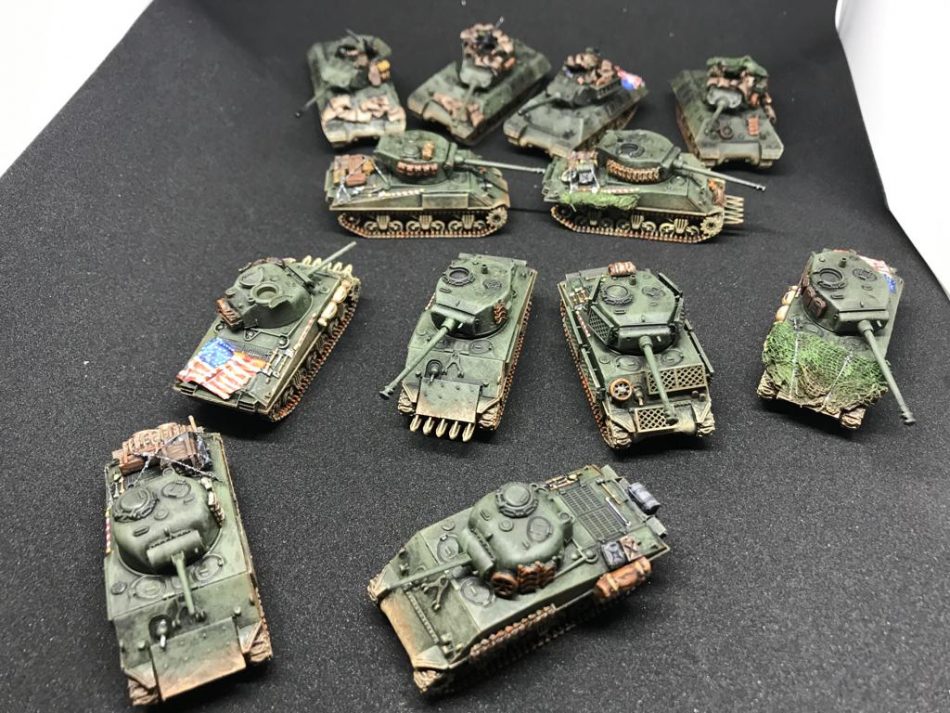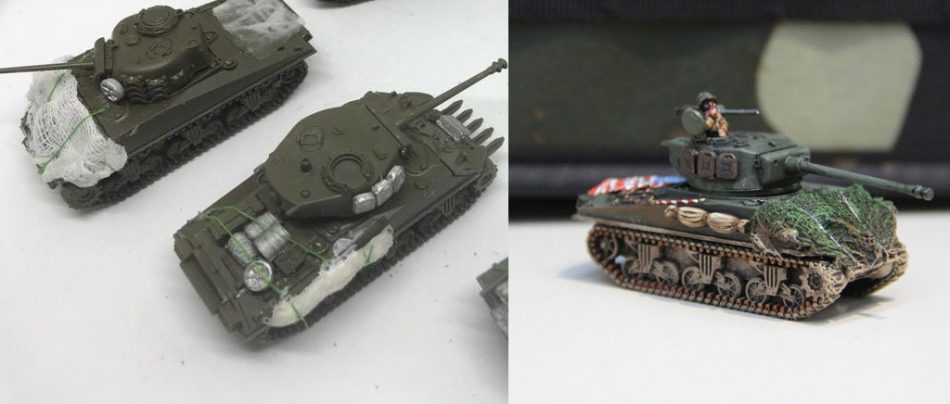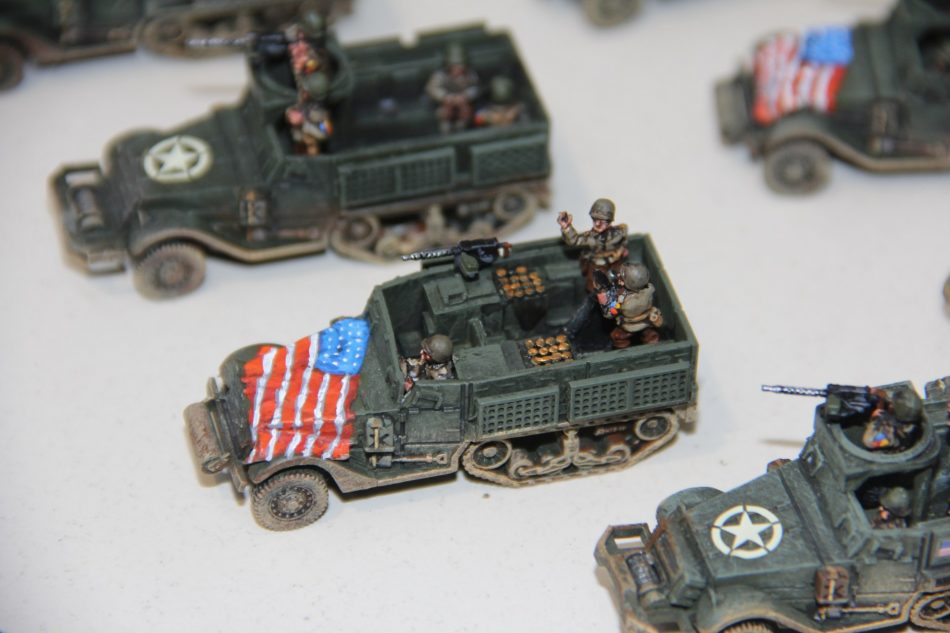Painting a FOW Army: how to field totally unique tanks and vehicles
D-Day is coming! In June (could be any another month?) Battlefront will publish army lists for the Normandy landings, effectively starting the Late WW2 period. After years fighting with “hit on 3+” and “test morale on 5+”, US troops will finally get much better, with tanks able to worry the German counterparts. For this reason, I began to assemble my new US army, with a mix of Mechanized infantry, Shermans, M3 halftracks, 105mm artillery, and M10s to punch enemy armour. But I also wanted a “personal” army, something really unique. Each tank with a different layout, each infantry base with a personal touch.
In this first half of the US Late Army painting guide, we will see how to customize your tanks (they can be German or Russian, obviously) with some tricks and advice to have flags, sandbags, and nets where you want.
First rule: build a “bits” box
Almost every Battlefront sprue (and also the competitors’ ones, like Plastic Soldiers) comes with some variations. Fuel tanks, wheels, cutting blades. If you are building a platoon of five tanks, you won’t have the same wheel on all of them, so you should have some spare parts unused. These pieces must go in the special “bit” box, where you will place all unused parts. When it comes to our hobby, I think I am a perfect example of crazy hoarder: I also keep turrets, cannons, guns. Everything could, sooner or later, prove useful.
 Some of the bits we’re going to use for our brand new US army – they came from everything “15mm”, even ancient equipment from a Baueda Roman Camp
Some of the bits we’re going to use for our brand new US army – they came from everything “15mm”, even ancient equipment from a Baueda Roman Camp
Get some reinforcement: Baueda and Battlefront bits
If you want to give a personal touch to your army, you should invest some money with Baueda and Battlefront resources.
. In their “Cama range”, they have desert, rural, and urban bases for your infantry, guns and MGs, some of them already with four or five holes for your soldier’s oval. Baueda also has a range of 15mm bits, like boxes and chests.
Some useful links:
. Fuel tanks and boxes, with one fuel can. Also, on the same page, you could be tempted by LG S9, baggage elements, LG 2 Generic supplies, and LG S3 Napoleonic supplies.
. These dug-in markers are “U” shaped and should be placed in front of infantry or gun bases to state their dig in status. However, you can easily cut them and use for infantry bases elements or small bits placed on the tanks.
. The walls are sculpted simply deliciously, and it’s really easy to paint them in a red brick scheme. Some bases are the old version with 5 holes, so you’ll need to fill them, but they are extremely good. On the same page, you can find some extraordinary objectives, like the downed BF109.
. Perfect for French or Italian countryside, although less characteristic than the Urban ones.
All these bases can be used also for Team Yankee, so don’t worry if you buy one or two more. Sooner or later you will use them.
 Some of the Baueda bases we’re going to use for our infantries, and also two Battlefront “big guns” bases” specifically made for our US 105mm artillery guns.
Some of the Baueda bases we’re going to use for our infantries, and also two Battlefront “big guns” bases” specifically made for our US 105mm artillery guns.
Battlefront has some boxes built for enhancing the tanks apparel. They are not that cheap, but worthwhile if you are starting a brand new force, or if you plan to share them with some friends who also want to enhance their units. You can mix them up, but remember that German wheels are normally bigger than the Western Allied ones.
and you’ll find plenty of options.
We used MSO102 US Tank Stowage, the German one (GE670), the US Vehicle (TUSO10), the Soviet one (SU670).
Also, you can add the XX106 and XX107 plastic bases sets. The rural one is really good, with plenty of options. We will cover the infantry bases in the second half of this feature.
 That’s what I call a “good start”. Lots of bits to have a unique look on your tanks, all of them!
That’s what I call a “good start”. Lots of bits to have a unique look on your tanks, all of them!
Green stuff
Another step you need to take: buy some Green stuff (also available on Amazon, nowadays) and try to sculpt what you need. Even if you have zero experience, you can create sandbags, for example, or use it to fill gaps on the bases. , but you can find a similar product in the nearest Games Workshop store if you don’t want to go online.
How to paint the US Army tanks
The base colour is Olive Drab, a peculiar dark green. I’m not going to spend much time on this, since you can find lots of references on Osprey books, on the BF army lists, and countless photos online. Basically, the US tanks and vehicles are dark green.
The best way is to build all your units, then use an airbrush with Olive Drab (I used the Tamiya XF-62) to paint all army with the same tone. After the base colour is totally dry, drybrush with a lighter tone (I used the same Olive drab and some drops from Vallejo Pastel green, 70.885). For a full army, you need to have a good stock of paint pots, at least three Olive drab. You can also buy pre-made spray cans with Olive drab, but it’s much more expensive.
Since all US armours are of the same green, you will want to “break” this colour. Boxes, ammo crates, fuel tanks can be painted with different shades of brown, while nets need to be of a totally different green tone. Tracks and wheels on the tank armour can be painted with a rust/orange look, also. Some flags can complete the picture, and make up a more colourful army.
 All green is not fun: better to “break” the scheme with some brown and rusty orange, plus some proud Star and Stripes flags! At this stage, the tanks were still missing the MGs and the crew.
All green is not fun: better to “break” the scheme with some brown and rusty orange, plus some proud Star and Stripes flags! At this stage, the tanks were still missing the MGs and the crew.
Some ideas to give a unique touch: nets
To create rolled up nets, the easiest way is to use medical gauze. Just roll it in 2 cm (or the length of the side of your tank) and glue with PVA / Vinavil glue. When dry, paint it with a different tone of green from the tank surface (or it will look “fake”), with a light drybrush of a paler tone. If you do it on modern tanks, you can add some tea leaf from a tea bag (before drinking it) when you use the glue. The micro-leafs will be perfect for modern looking nets.
 The nets just glued to the tank and the final result. It’s really important to colour them with a different shade of green, or the tank will look fake – “how comes the net is the same olive drab used back in Detroit when the tank was built?”
The nets just glued to the tank and the final result. It’s really important to colour them with a different shade of green, or the tank will look fake – “how comes the net is the same olive drab used back in Detroit when the tank was built?”
Blades
After D-Day, US tanks faced the bocage, a maze of impenetrable bushes of the French fields. They used cutters to pass thru them: the Late US army Sherman sprue already has these blades, but yu can save some and use them on some M10s or Pershings, to make them look even more deadly!
Things on the back, but with cables.
 The back of some heavy loaded Shermans, with the green cotton cable. I used the one they give you in the hotel packs. You can place it also on the nets.
The back of some heavy loaded Shermans, with the green cotton cable. I used the one they give you in the hotel packs. You can place it also on the nets.
Usually, tank crews stocked all kind of stuff on the back of their vehicle. The more “random”, the better, but remember the tank is a moving vehicle, so try to be realistic when you “pack” your items. Here you can add any sort of boxes (on the Sherman in the photo I placed some spare ammo boxes from British guns), bags and fuel tanks. I also placed some machine guns: on the Sherman sprue you will find more cal .50 than you’ll ever need, so a couple could be placed as spare and backup – you can remove the side ammo box.
I also wanted to place the steel cables used to keep the things in good order. After you have glued the stuff, you can add a single cotton cord, with a small drop of super glue to instantly fix it. You need to place the cord in a realistic way: the crew tied them to handles, they didn’t glue it! You can then paint it black and drybrush with small touches with iron/gunmetal paint.
Flags
Flags were used on the top of vehicles to avoid friendly fire from planes: after D-Day, there were so many different Allied vehicles moving towards Paris that was impossible for a pilot to recognize their silhouette. So, it’s good to have flags on Allied tanks, while I think Axis ones would have avoided to show with such enthusiasm their alliance upwards, considering the sky was dominated by British and US fighters.
Creating a flag is not that difficult, but I’d suggest to try with a spare model part you don’t need, something you can throw away if the experiment is not that positive. I use paper tissues like Kleenex. You just need to cut the dimension you want on your tank. [Editor’s Note: I’ve had good results using an ink-jet printer with Tracing Paper as the print stock].
A Sherman is 2,60 metres wide, and a flag can be 1.50/2.00 metres, so it should be smaller than your Sherman, like one/third smaller. You need to keep two or three layers from the paper tissue, and glue it to the tank following the obstacles on the tank itself – the flag will never get totally flat, it will cover handles and other irregular surfaces, with some folds. Glue it with abundant Vinavil glue, and let it dry. Don’t worry if the paper becomes transparent, it is still there.
When painting, just start from the base colour. Russian flags are the easiest, as Italian or French ones. US or British are a bit more demanding. If you paint the US flag, paint it red and drybrush with red/orange, then do the blue quarter (always top left!). You can add some stars with really small white dots. For the Stripes, paint six grey lines – check on Google for reference, the blue quarter ends with a red line, and you need to draw three grey lines on the blue quarter side. When dry, highlight with pure white, leaving some grey behind to give a three- dimensional effect.
 How to place a flag on your vehicle: paper tissue with water glue like PVA/ Vinavil; base colour; the main colours (red and blue) already shaded/highlighted, and the final result. You need to give realistic folds at step one.
How to place a flag on your vehicle: paper tissue with water glue like PVA/ Vinavil; base colour; the main colours (red and blue) already shaded/highlighted, and the final result. You need to give realistic folds at step one.
Tracks and wheels
Tank crew often placed track sections or wheels on their tanks to improve shielding. I don’t think a 88 shell could be worried by some tracks, but better this than nothing, I suppose. Lots of sprue has spare tracks you can glue around your tanks. The best spots are the front armour, the side of the turret and the side of the tank itself. Just remember the tracks had normally the “spikes” on the top, the flat surface towards the tank. Normally they were used portions, so you should paint them metal with earth or rust. No place for brand new equipment!
 Browns and rust/orange are really important to “break” the green scheme of the US armoured batallion; another good trick is to pinpoint with brownish orange the “needles” of the tracks.
Browns and rust/orange are really important to “break” the green scheme of the US armoured batallion; another good trick is to pinpoint with brownish orange the “needles” of the tracks.
Sandbags
It’s not easy to find pre-made sandbags in 15 mm scale, although they are quite common in 1/72 or 28mm kits. But no worries, they are easy to do them yourself. Just buy some Green Stuff: you will need to merge the two modelling clays (normally, they have different colours). You need to roll them in long “sausages”, roughly 0.5 cm thick. Now the magic trick: leave this “sausage” alone to rest for ten minutes and it will begin to dry. Flatten it on one side, and you will have a long strip, and if you cut it you will have single sandbags, flat and with the ends squished.
You just need to place them in rows on the tanks: I think they are notably useful on open-top tanks like M10 or M36, but you can place them also on the front of some Sherman. I don’t think they make sense on a Tiger or a Pershing, with their superarmours. To paint them, simply have a base with a whitish sand colour, cover it when dry with a brown ink, and drybrush twice with a lighter tone. Sandbags are very good to “break” the all green tone of a US Army tank army.
 Some M10s needed an improved armour on the front: the green stuff came in help. On the left, before paiting, on the right, the M10s on the battlefield, sharing some heavy rounds.
Some M10s needed an improved armour on the front: the green stuff came in help. On the left, before paiting, on the right, the M10s on the battlefield, sharing some heavy rounds.
Weathering
There are a lot of modelling products to reproduce the weathering effects, like sands, dirty, rust and so. I think on a 15mm scale it’s more than good to just have some drybrush. The first layer should be of a medium brown. Tanks and halftracks moved in the countryside, and it rained a lot both in June ’44 and in later months, so be generous.
The second drybrush passage should be done with a lighter tone, closer to the sand colour. This one will cover 80-90% the first one, and the final effect will be a mix of dried and fresh mud on the lower surfaces of the tank, and on the sides. Be also generous on the tracks. You can add some Bolt gun/Steel touches on the edges of the vehicles to simulate the scraped surface, but don’t exaggerate!
 Look how the mud is on the lower half of the tanks. Also, you can see some “scratches” on the “bed” protections on the right/centre tank: few touches, don’t exaggerate!
Look how the mud is on the lower half of the tanks. Also, you can see some “scratches” on the “bed” protections on the right/centre tank: few touches, don’t exaggerate!
The final results
Some photos of the full army, ready to fight some serious battle. We will be back soon with a similar feature on the infantry and guns bases, so stay tuned!
 The “beds” on the side were common on the Eastern front, but you can imagine some yankee also improvised to avoid grenades.
The “beds” on the side were common on the Eastern front, but you can imagine some yankee also improvised to avoid grenades.
 Try to paint every little detail, like the red/white coloured measurement sticks. Also, try to have different shades of brown for the baggages, from the light yellow tone to the dark one.
Try to paint every little detail, like the red/white coloured measurement sticks. Also, try to have different shades of brown for the baggages, from the light yellow tone to the dark one.
 Having 8 Shermans, each with a unique style, is not that difficult. The flags should signal out the leaders of the platoons: they are really important, since they can order Artillery barrages with the special US rule.
Having 8 Shermans, each with a unique style, is not that difficult. The flags should signal out the leaders of the platoons: they are really important, since they can order Artillery barrages with the special US rule.
Do you want to learn more from Paolo or others about painting? Do you have tricks and tips of your own to share? to discuss the tactics and play styles for these new additions to FOW V4. Not a member of our forums? Just send Iron-Tom an email and he’ll get you set up with a login. .
